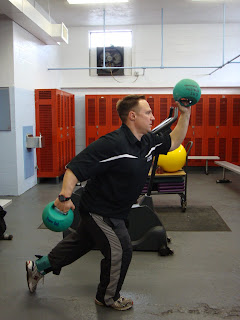


 Remember in gait as in running, the posterior lower leg muscles don't plantar flex the ankle- momentum is giving you that for free. Rather, they extend the knee by decelerating the tibia.
Remember in gait as in running, the posterior lower leg muscles don't plantar flex the ankle- momentum is giving you that for free. Rather, they extend the knee by decelerating the tibia.So if you are doing eccentric heel drops or single leg standing while tossing a med ball into a plyoback, they probably won't help with your chronic calf strains. You've got to get the knee to translate beyond the toes if you are looking to load it ecconcentrically.
Here are two of my favorite exercises; they would be placed in the latter phases of rehab if you are returning from a strain because I'm using an ankle cuff & powerballs to increase the load.
The lower extremity motion is the same for both; that is an anterior to posterior pivot balance and reach. In the top photo I'm doing a BUE posterior @ overhead reach to anterior toe touch and return. Be sure to keep the front leg slightly bent and the foot slightly plantar flexed so the exercise does not become a standing slump test. You don't need to reach the hands all the way to the foot as I did either.
In the bottom pics I'm using opposing arm drivers to simulate running.
Begin in the sagittal plane and advance to right and left diagonal. In the early phases of rehab it is easy to tweak down by standing horizontal to a wall and allowing the inside hand to touch as necessary to assist in balance. The free hand would go through the same motions as in the picture.
If you're new to them, your going to feel a deep burn in posterior lower leg, the VMO of the knee, and the low back. Exactly how these muscles are integrated in running. Begin with 3 sets of 10, but work up to 4 sets of 20-30.
5 comments:
Joe,
Great stuff. Is it advisable to put the ankle cuffs on both legs and alternate? How much weight on the cuffs? Any chance for video Joe for us old guys who need a little more visual? Jack Martin
Joe,
Have you used these exercises in achilles & patellar tendinosis?
Kevin Moody
Thanks for checking in Coach Martin.
-If you mean alternate REPS from side to side, then no because it would create too much rest in between reps. However, if you mean you want to have cuffs on both ankles to save time as you alternate from R to L leg, then that sounds good to me.
The weight of the cuffs depends on your progression. Definately start out with just bodyweight on both exercises and do it till you no longer get that deep burn in the calf. I'm using a 7lb med ball and 5lb cuff in the pic.
I would love to start a youtube channel if I only had the time! This post I did (pics & all) in between innings at a baseball game!
As far as some fine points for the exercise,
-remember it is the leg reach that is initiating the knee bend; its not a single leg squat with a reach.
-Be sure the toes are pointed straight ahead and you are not "bailing out" of dorsiflexion )a common cause of medial calf strains)
-On the first one in the pic, be sure to keep the front leg slightly bent and the foot slightly plantar flexed so the exercise does not become a standing slump test. You don't need to reach the hands all the way to the foot as I did either.
Kevin- No, I haven't; but you gave me a great idea. I never considered the concept of the gastroc/soleus controlling the foward knee excursion that could contribute to patellofemoral issues, but you are right on! And, I like the idea of the arm reaches moving the center of gravity forward to load the achillis a little better.
Great stuff as always Joe.. Thanks.. Your buddy Urbs has quite a few stories about you.. I got a great camera to help with the YouTube idea. Lets hold a massive recording session one day and get the stuff up.. We can get it done together..
Good post Joe! The exercises you demonstrate are almost like snake oil (I mean that in the most complimentary manner) in that they are applicable to so many different things. Thanks to you from some previous interactions I have learned to use this type of exercise for ankle sprains and Achilles issues, calf and shin pain, as well as for knee/hip rehab.
Post a Comment